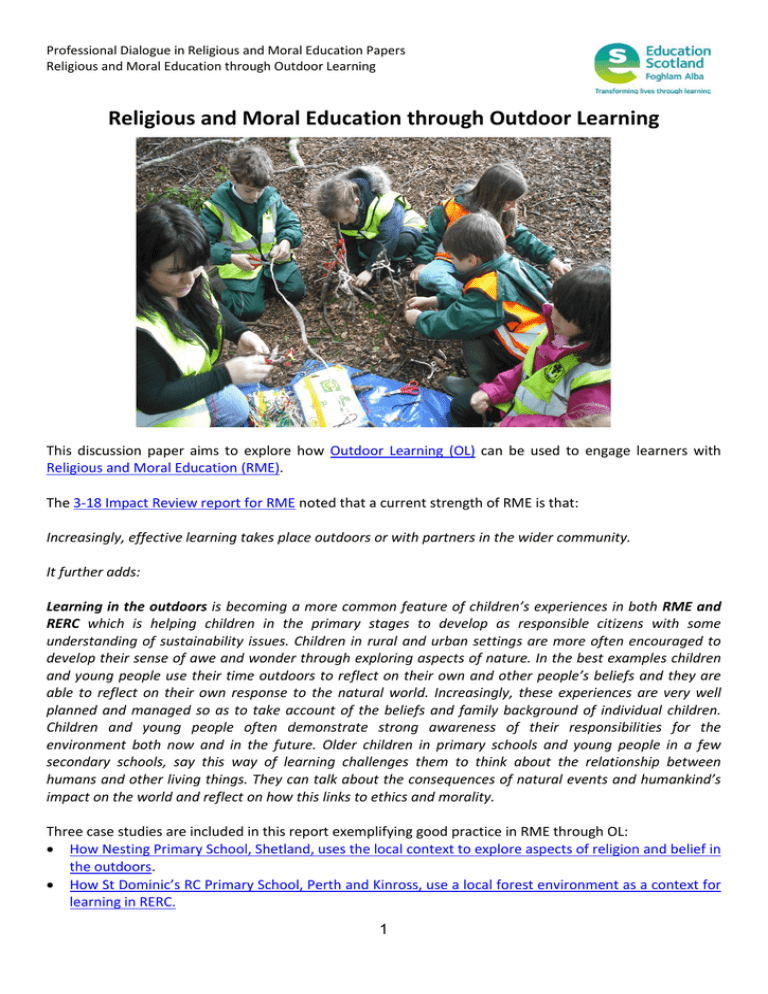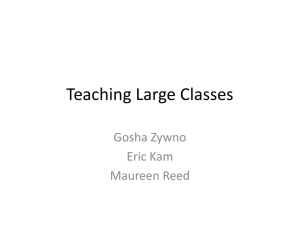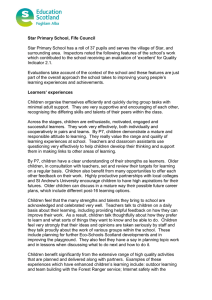Professional Dialogue in Religious and Moral Education Papers
advertisement

Professional Dialogue in Religious and Moral Education Papers Religious and Moral Education through Outdoor Learning Religious and Moral Education through Outdoor Learning This discussion paper aims to explore how Outdoor Learning (OL) can be used to engage learners with Religious and Moral Education (RME). The 3-18 Impact Review report for RME noted that a current strength of RME is that: Increasingly, effective learning takes place outdoors or with partners in the wider community. It further adds: Learning in the outdoors is becoming a more common feature of children’s experiences in both RME and RERC which is helping children in the primary stages to develop as responsible citizens with some understanding of sustainability issues. Children in rural and urban settings are more often encouraged to develop their sense of awe and wonder through exploring aspects of nature. In the best examples children and young people use their time outdoors to reflect on their own and other people’s beliefs and they are able to reflect on their own response to the natural world. Increasingly, these experiences are very well planned and managed so as to take account of the beliefs and family background of individual children. Children and young people often demonstrate strong awareness of their responsibilities for the environment both now and in the future. Older children in primary schools and young people in a few secondary schools, say this way of learning challenges them to think about the relationship between humans and other living things. They can talk about the consequences of natural events and humankind’s impact on the world and reflect on how this links to ethics and morality. Three case studies are included in this report exemplifying good practice in RME through OL: • How Nesting Primary School, Shetland, uses the local context to explore aspects of religion and belief in the outdoors. • How St Dominic’s RC Primary School, Perth and Kinross, use a local forest environment as a context for learning in RERC. 1 Professional Dialogue in Religious and Moral Education Papers Religious and Moral Education through Outdoor Learning • How Forres Academy, Moray, use the Standing Stones at Calanais as a context for learning about spirituality. How can OL help learners to engage with RME? In the document Assessing Progress and Achievement in RME, the significant aspects of learning include three which can be supported through OL. What does this mean in practice for the relationship between RME and OL? Learning in the outdoors is becoming a more common feature of children’s experiences in both RME and RERC which is helping children in the primary stages to develop as responsible citizens with some understanding of sustainability issues. Experiencing a sense of awe and wonder about what it means to be human, the nature of the world we live in, the interconnectedness of it all and developing a deepening sense of spiritual awareness Being outdoors helps learners to consider their own relationship with nature and develop respect for it and their place in it. It can help learners to understand that ‘the environment’ isn’t something ‘out there’ but is something that we are part of. This interconnectedness of life on earth can help learners to develop awareness of their dependence on others and how others depend on them. It can help learners to consider what the word ‘spiritual’ might mean – and how far it might apply to them. This can help learners to develop their own beliefs and values, through interacting with others and drawing on the world’s religions and belief systems. This goes right to the heart of what RME is all about – understanding what it means to be human and the relationship between beliefs and action. Developing skills and attributes to make well-judged moral and ethical decisions and to justify personal beliefs and values Being outdoors gives learners the chance to think about wider environmental and sustainability issues. Through developing a sense of the value of nature, learners are more likely to want to protect it. Human interactions with the environment are complex, but the process of starting to question and act upon how people treat nature is likely to begin with experience. When learners experience nature they are more likely to question how we treat it. Learners will already have beliefs and values about nature – being outdoors can contribute to challenging and so developing those beliefs and values. This interconnectedness of life on earth can help learners to develop awareness of their dependence on others and how others depend on them. It can help learners to consider what the word ‘spiritual’ might mean – and how far it might apply to them. Engaging in a process of personal reflection leading to a deeper understanding of personal beliefs and ideas about meaning, value and purpose in life. A key aspect of RME is reflecting upon our own beliefs and values and those of others. It also means thinking about how those beliefs and values lead to actions – or inaction – and what the consequences of this is. What we think about nature affects how we treat it, and how we treat it has consequences. Being outdoors can help learners to reflect about their place in life – and what it all means. 2 Professional Dialogue in Religious and Moral Education Papers Religious and Moral Education through Outdoor Learning How can OL be used in RME? Many establishments already make good use of OL to explore a range of curricular areas. Here are some possible suggestions about how OL can be used in RME. The school’s garden Many schools have gardens. These are used for outdoor play, and often for learning about natural processes such as the seasons. Could an area in the school’s garden become a ‘contemplation space’? This would be an area of the garden designed for quiet reflection, and could involve the use of an alreadyexisting natural feature, such as a rock or a tree, or the creation of a special feature, such as an area of raked sand or a religious symbol such as a labyrinth. This area could reflect local cultures and beliefs, but could also be used in relation to world religions – where objects linked to world religions could feature in the garden. Outdoor spaces linked to religious and cultural sites Local religious buildings often have outdoor spaces such as cemeteries. These can reveal much about the beliefs and values of the religion associated with the site – for example, beliefs about life after death as evidenced in the inscriptions on headstones through time. Also, local memorials, such as war memorials can also reveal much about society’s beliefs and values. There are specific grottoes in Scotland which may be of interest as ways of exploring specific religious traditions. Many religious sites have outdoor areas which continue the show the beliefs, values and practices of the religion in an outdoor context. As well as this, there are many religious and cultural sites of interest throughout Scotland – standing stones, ‘cup and ring’ structures, ‘sacred caves’, wells, and many other examples of evidence about beliefs past and present which can engage learners in thinking about many issues linked to RME. Wild places Taking learners on visits to truly wild places may be a unique experience for many learners. Such wild places can often be closer to home than might be imagined, and can provoke a range of responses from learners about the importance of wild places and human responsibility for them. Forest walks, beachside walks, viewpoints, twilight strolls in wild places, gazing at the stars on a clear dark evening – watching a sunrise or sunset – all can be used to help learners reflect upon nature, their role in it and responsibility for it. In such wild places, stories can be told – stories linked to the place or set in the same context. Or these can be stories from the world’s religions – the parable of the calming of the storm told while looking out to a stormy sea for example. 3 Professional Dialogue in Religious and Moral Education Papers Religious and Moral Education through Outdoor Learning How might learners use and respond to these OL contexts in RME? Learners might: • • • • • • Forest walks, beachside walks, viewpoints, twilight strolls in wild places, gazing at the stars on a clear dark evening – watching a sunrise or sunset – all can be used to help learners reflect upon nature, their role in it and responsibility for it. Write a poem, song, or piece of reflective writing about an OL experience Design and/or create a ‘contemplation space’ Consider the value of reflective practices such as mindfulness in outdoor contexts, and engage in discussion about this Make use of objects from outdoor learning contexts to explore religious, moral and philosophical questions to develop their thinking about nature Investigate ways in which nature is harmed – locally or globally by human action, and evaluate a range of responses to this Consider the role of nature in relation to the world’s religions and belief-systems. What do they say – and do - about the relationship between people and place? Linking learning in RME through OL Many establishments already engage in programmes linked to Outdoor Learning. This can range from outdoor activity events and residential experiences to structured programmes and engagement schemes/frameworks such as EcoSchools or John Muir Awards. As establishments are often already engaged in these approaches to OL, it is a short leap from this to taking a focus which is specifically linked to RME. For example, might an outdoor learning activity or camp include an element of exploration of beliefs, values, practices and traditions of world religions or belief systems? Could one or more of the nine topics in the eco-schools programme be specifically linked to beliefs and values across one or more world religions or belief-systems? Could activities relating to John Muir Award challenges be explicitly linked to the beliefs, values, practices and traditions of world religions, belief-systems or spiritual approaches to life? Some practical matters RME through outdoor learning offers a wide variety of opportunities and experiences for learners, though some considerations should be borne in mind; • • Health and safety – all outdoor learning experiences must follow the health and safety/ child protection procedures relevant to your establishment. Education Scotland has produced advice and guidance on health and safety Appropriateness of activity – careful thought must be given to the potential impact of outdoor places on learners, and staff must ensure that places and experiences are appropriate for learners 4 Professional Dialogue in Religious and Moral Education Papers Religious and Moral Education through Outdoor Learning Professional Dialogue prompts • How can OL support the delivery of high quality RME? • What OL opportunities exist in the grounds of your establishment? • What OL opportunities are possible within reasonable travelling distance? • In what ways can you use an OL experience in ways which specifically address significant aspects of learning in RME? • What resources already exist/will you require to produce to support your OL/RME experience? • How might programmes and schemes such as Eco-Schools and John Muir Awards link to RME? • What support might be available in your own school community in relation to OL and RME? • How can OL be used to develop higher order thinking skills in relation to RME? • How are you involving staff, learners and the community in planning OL experiences which support RME? • How are you using self-evaluation to reflect upon your OL and its link to RME? • How can OL experiences linked to RME provide opportunities for learners to show progression in their learning? • How can staff develop their own understanding of the use of OL in RME through Career-long Professional Learning • What practical guidance is available to support outdoor learning and how well are we making use of this guidance in relation to RME? 5





